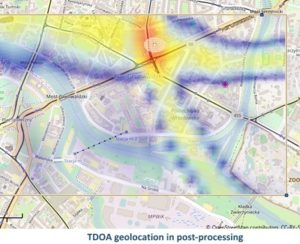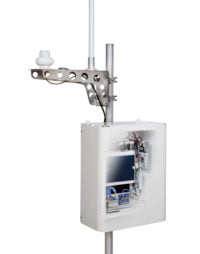
Expanded and updated, November 2020
Just seen an interesting transmission appear on your spectrum, but now it’s disappeared? Need to know where it came from, but you weren’t running a geolocation task at the time? Tough luck, it’s gone forever. If you’re lucky, you can sit there staring at your screen and it might pop up again.
Sounds ridiculous? That’s what we thought, which is why we developed our geolocation in post-processing capability, so you can perform TDOA geolocation retrospectively on recorded spectrum data. Geolocation in post-processing adds flexibility to your spectrum monitoring missions, enabling applications previously unachievable.

RFeye Node in Outdoor Kit
Remote autonomous monitoring
For example, you might want to leave a Node or an RFeye Stormcase in a remote area to operate autonomously. If there’s no network infrastructure available to send spectrum data over IP, then real-time geolocation will not be possible. However, the Node can be left to record spectrum data which is then retrieved later for geolocation in post-processing. In many scenarios not requiring a real-time geolocation and response to detected signals, this is the perfect solution to get around infrastructure constraint issues.
Triggered record
If Nodes are being left for long periods of time and you don’t want to end up wading through hours or days of uneventful recorded data, you can also use our triggered record capability. This allows frequency masks to be set up so that only signals of interest are recorded. You might then be left with just a few minutes of interesting signals which you can analyze and geolocate – a much lighter and less tedious workload than if you had to search the data for them first.
Portable RF Spectrum monitoring
As well as using a fixed Node to record snippets of data for post processing, you can also use an RFeye Stormcase. The key advantage of the Stormcase is its mobility. The portable RFeye Stormcase can be preconfigured to record on trigger and then left in a remote location. At the flick of a switch, data can be autonomously written to disc without any operator input. Once the mission is over, the Stormcases can be retrieved and any signals recorded can be geolocated in post-processing.
Never miss a signal
Real-time, but short duration signals are another application. Many signals which transmit as short duration bursts, such as GSM or WiFi, will re-transmit at regular intervals so you probably won’t miss your chance to geolocate them. With some signals, however, you will only get one chance. For example, a vehicle using a GPS jammer might have driven through a network of Nodes, or a push-to-talk (PTT) radio may have only broadcast for a second. Recording the I/Q data will ensure you can locate such devices even if you were not geolocating in that frequency band at the original time of the transmission.
Process and geolocate signals in bulk
Post-processing is also ideal for less time-critical applications which don’t require real-time geolocations. In these scenarios, it may be more efficient to collect data over days, weeks or months and go back to analyze it in bulk at a later date, deciding what’s important and requires geolocating after the fact.
Example: Military – Signals Intelligence (SIGINT) collection
A covert military unit have been tasked with locating an enemy command post. Using three RFeye Stormcases with triggered recording, they collect signal data from PTT radios over a period of days. Once post-processed back at headquarters, not only can this data provide intelligence from the decrypted COMINT, but the location, size and structure on the enemy can be determined from the captured signals.
Example: Industrial Interference
Some operations might mean that the need to geolocate (or look at spectrum at all) is known only in hindsight. For example, a factory is using continuous monitoring for avoiding and diagnosing spectrum interference and congestion issues. They decide to record data so they don’t have to respond to issues in real time. A problem with the factory’s wireless automation system prompts them to go back and look at recorded spectrum data to diagnose the issue. If interference is identified, they can geolocate to find the source. Even if the source is no longer in the same place, e.g. it might have come from a delivery vehicle, cross-referencing geolocation data with CCTV and event logs can still be used to diagnose the cause of interference.
Geolocation in post-processing, along with automation features for triggered record or alarms, enable RFeye users to achieve more flexibility with their spectrum monitoring, to analyze and geolocate when and how it suits them.
Find out more about our geolocation capabilities in our White Papers.
